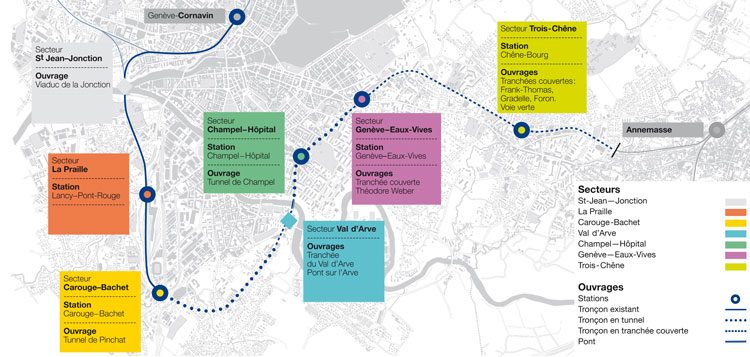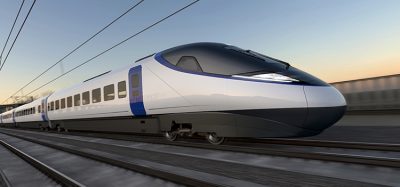Swiss rail construction projects on track – in cities, through the Alps and across borders
Posted: 1 August 2012 | | No comments yet
Throughout 2012, SBB Infrastructure is undertaking a number of construction projects across Switzerland: in the two largest Swiss cities, Zurich and Geneva, in the St. Gallen and Schaffhausen conurbations, in the canton of Ticino, in the Alps, and even beyond Switzerland’s borders. This article presents an overview of the major ongoing construction projects, describing the progress achieved so far and what work still lies ahead.


The Swiss Federal Railways (SBB) network is the world’s busiest rail network, carrying approximately 9,800 trains every day to all parts of Switzerland and, not surprisingly, the network is edging ever closer to its capacity limits. Zurich’s main station – serving almost 400,000 passengers a day, and thus by far the busiest station in Switzerland – is already a major bottleneck, while capacity expansion in other parts of Switzerland is also urgently needed. SBB Infrastructure is responsible for operating, maintaining, expanding and renewing SBB’s rail network. With the exception of the Gotthard Base Tunnel, SBB Infrastructure is in charge of all major railway upgrades in Switzerland. Projects demanding a wide range of construction techniques are underway all across Switzerland, and some even extend into neighbouring countries. The largest, most important and most spectacular of SBB Infrastructure’s current expansion projects1 include the following:
The Zurich Cross-City Link2
Zurich is Switzerland’s largest city, and its main station, Hauptbahnhof, or HB, is the country’s busiest rail interchange point. Zurich also lies on the national rail network’s key East-West corridor that stretches from Geneva to St. Gallen via Lausanne, Berne, Zurich and Winterthur. Up to now, trains on this route perform a time consuming back-shunt in Zurich’s terminus station, which is also stretched to its limits in other ways – particularly in the immediate approaches and the terminus’ track field.
The new Cross-City Link is designed to alleviate this bottleneck. This new, approximately 10km-long line links Oerlikon, a district in the northern part of Zurich, via a tunnel with the new Löwenstrasse through-station which is being built underneath the HB. From there, trains will take an accelerated route across the station’s track field, passing over two viaducts on their way to Altstetten on the city’s western edge. There, the Cross-City Link will rejoin the existing long-distance lines heading to western Switzerland.
Zurich’s Cross-City Link is the largest inner-city construction project currently underway in Switzerland. With a project volume of some two billion Swiss Francs, it is also currently SBB Infrastructure’s largest undertaking. The scale of the expansion work is extensive. The Löwenstrasse station is being built underneath the existing tracks of the HB terminal buildings without any interruption to ongoing rail operations. During work to bore the Weinberg tunnel, which has already been completed, good care had to be taken to protect the city districts under which the tunnel passes – in places with very little coverage. In Oerlikon, SBB Infrastructure is working in a very confined space and in the vicinity of Switzerland’s seventh largest station – also without significantly constricting rail operations. Furthermore, SBB Infrastructure is using a launching girder to erect Switzerland’s longest jointless rail bridge across the track field of the HB, while down below at ground level trains continue to run normally.
Work on the Cross-City Link is now in its fifth year and remains on schedule. Rail operations on an initial section of the line are due to commence in mid-2014, when S-Bahn (rapid transit) trains start using the new link. However, construction of the two viaducts that in the future will serve to exit the underground Löwenstrasse through-station will take some – what longer. Their completion depends on elimination of the tracks currently used by the S-Bahn services that will run via the new Cross-City Link as of 2014. Therefore, SBB Infrastructure will not complete the viaducts until 2015. But by the end of that year, longdistance trains travelling the East-West corridor will also run via the Cross-City Link.
Geneva: Cornavin–Eaux- Vives–Annemasse (CEVA) rail link3
In Geneva, Switzerland’s second largest city, SBB Infrastructure is also expanding the existing rail network. Or, more precisely, two existing rail networks – because until now, the Swiss and French networks have terminated in Geneva like two separate cul-de-sac roads. The ‘CEVA’ link connecting Geneva’s main station Genève-Cornavin via Eaux-Vives with Annemasse on the French side of the border will join up the two networks. The new line is approximately 16km-long, with around 80% of it routed underground.
CEVA forms the core of the future Réseau Express Régional Franco-Valdo-Genevois (RER FVG) rapid transit network. This will span 230 route kilometres and 40 stations, from Coppet-Nyon in Switzerland to Annemasse and Bellegarde in France. In terms of mobility, urban planning and environmental protection, the entire Geneva conurbation, with its popu – lation soon to top one million, will directly benefit from CEVA and the RER FVG.
SBB Infrastructure began construction work in 2005 in one of the seven sectors making up CEVA. Ground-breaking for the remaining work took place in 2011 once all of the approximately 1,700 objections filed had been rejected by the Federal Administrative Court. But this project is by no means new: as long ago as June 1881, France and Switzerland concluded their first treaty aimed at linking the two rail networks.
Building CEVA is estimated to take six years and will include the construction of two tunnels, five stations (including the associated infrastructure), two bridges, and a green belt to replace an existing railway line that is to be rerouted underground. 2012 is witnessing preparatory work on all fronts, which will take one to two years. This will be followed by four years of work to bore the two tunnels and construct the cut-and-cover sections and bridges. The final two years of the allotted construction period will be dedicated to technical rail installation work and fitting out the stations.
CEVA – truly a project of the century – is scheduled for completion in 2017. The borders between the two countries will then no longer be an obstacle to the region’s public transport services.
The Lake Geneva region: increasing capacity with ‘Léman 2030’
The Lake Geneva region is Switzerland’s second most important business location, surpassed only by Zurich. To SBB, this region presents major growth potential. SBB currently carries up to 50,000 passengers every day between Lausanne and Geneva, with an additional 11,000 people on Geneva’s future RER FVG and 27,000 on the Lausanne rapid transit network (REV). The number of passengers is expected to double by 2030 to around 100,000 travellers daily. The Geneva and Lausanne rapid transit networks will expand their services and introduce additional trains capable of dealing effectively with the increased demand. Furthermore more, the future link between Geneva and Annemasse has outstanding growth potential.
With the project ‘Léman 2030’, SBB aims to increase the capacity between Lausanne and Geneva and, from 2020, rapid transit services will run every quarter of an hour. To achieve this target, the trains currently used on national routes will be replaced by double-deck units, and more efficient trains will be introduced on local services.
Alongside investments in new trains, developing the infrastructure is a further key factor to the success of Léman 2030. Adjustments are necessary at the rail interchange points of Lausanne and Geneva in order to accommodate growing customer numbers and service expansion. The project also aims to improve interfacing with urban public transport services.
Infrastructure costs for the first phase of the Léman 2030 project are estimated at approximately 2.5 billion Swiss Francs.
North-South corridor: base tunnels and OCC South4
The North-South corridor stretching from Basel and Zurich via Zug and through the Alps to Ticino in southern Switzerland, and from there on to Italy, is an important element of the Swiss rail network. The ‘New TransAlpine Rail Routes’ (NTARR) project currently underway is creating new rail routes on this TransAlpine axis. The Lötschberg Base Tunnel between Frutigen and Raron has already been in operation since 2007, improving North-South connections in western Switzerland.
The Gotthard and Ceneri Base Tunnels also form part of the NEAT project. With a length of 57km, the Gotthard Base Tunnel will be the longest railway tunnel in the world. Both tunnels are being planned and built by AlpTransit Gotthard AG (ATG) – a wholly-owned subsidiary of SBB.
These two base tunnels transform the Gotthard route – which up to now required trains to overcome a 500m difference in altitude – into a level-track rail line, reducing the maximum gradient from 2.6 to 1.2%. The route from Basel to Chiasso on the Swiss-Italian border will be shortened by 40km. These improvements make haulage of freight by rail a viable alternative to road transport. Passenger services will benefit from improved connections, shorter travel times (the journey from Zurich to Milan can be reduced to less than three hours) and approximately 25% more trains per day.
In Pollegio, near the south portal of the new Gotthard Base Tunnel, SBB Infrastructure is constructing the Centro d’Esercizio Pollegio (CEP) or Operational Control Centre (OCC) South. In the future, OCC South will control rail traffic on the network section from Arth-Goldau (located between Zug and the Gotthard Base Tunnel’s north portal in Erstfeld) to Chiasso, Luino and Locarno in Ticino. Work on OCC South is proceeding apace in 2012. It will be housed in a building noted for its striking architectural design.
Work at the AlpTransit Gotthard AG (ATG) construction sites is also progressing rapidly. Earlier in 2012, ATG began installing railway installations in the eastern tube of the Gotthard Base Tunnel between Amsteg and Sedrun. Tube boring on the Ceneri Base Tunnel is already halfway complete. The Gotthard Base Tunnel will open in 2016, with the Ceneri Base Tunnel to follow in 2019.
Ticino: Ferrovia Mendrisio–Varese (FMV)
Like CEVA, the Mendrisio–Varese railway (FMV) project is also designed to join two major rail networks via a link line carrying local services: this time the Swiss with the Italian. From the end of 2014, this new line running via Mendrisio and Varese will connect the Ticino city of Lugano with Milan-Malpensa Airport. This connection opens up new rail service opportunities for Ticino and northern Italy. For example, taking the Lötschberg route for journeys between western Switzerland and Ticino can become a truly viable alternative to the Gotthard route.
Preparatory activities on FMV have been completed, and civil engineering works have begun. In 2012, SBB Infrastructure is continuing its work on Mendrisio station as well as on the Mendrisio–Stabio–Confine section.
Construction work on FMV will continue until the end of 2013, with services on the new route due to commence in December 2014.
Zurich, St. Gallen and Schaffhausen: S-Bahn upgrade projects
In north-eastern Switzerland, SBB Infrastructure is expanding three local public transport (S-Bahn) networks at once: the existing S-Bahn networks of Zurich and St. Gallen as well as the new S-Bahn serving Schaffhausen.
As of December 2013, St. Gallen’s S-Bahn system will expand train services for eastern Switzerland by some 35% – including trains every half hour throughout the Canton of St. Gallen. Since ground-breaking in November 2011, construction work has proceeded on schedule.
Building work has also already begun in Schaffhausen. The city’s S-Bahn network is being created successively on the existing networks of SBB and Deutsche Bahn (DB), enabling services every half hour throughout the entire canton and every 15 minutes in the core conurbation area during peak times. Infrastructure upgrades are being implemented in stages accordingly. The first construction project – the new platform for track 6 at Schaffhausen station – will be completed and commissioned in December 2012. Schaffhausen will also benefit from efforts underway to improve connections between Switzerland and the European high-speed rail network: thanks to new double-tracking on the Zurich-Stuttgart route, Schaffhausen will benefit from half-hourly InterCity services to and from Zurich from December 2012.
In Zurich, the fourth phase of expansion to Switzerland’s first S-Bahn network5 has also been divided into stages. SBB Infrastructure has already launched the most urgent construction work, and official ground-breaking for these expansion projects took place in May 2012. Commissioning of the most urgent expansion measures is scheduled for 2014 – simul – taneously with the opening of the Cross-City Link for S-Bahn services. The Cross-City Link line is central to changes in rail services to be launched as part of the fourth phase expansion upgrades. From 2014, a total of four S-Bahn lines will be routed via the Cross-City Link. However, SBB Infrastructure is expanding the existing network throughout the rest of the canton as well, for example in the Winterthur area.
Eastern and Western Switzerland: connections to the high-speed rail network (HSR-C)6
A number of modifications at specific locations are due to be implemented by the end of 2015 in order to improve the Swiss rail system’s link to the European high-speed network. This will shorten travel times to the South of France, Lyon and Paris as well as Stuttgart, Ulm and Munich in Germany. Expansion work on connections to these high-speed rail services (HSR-C) is planned throughout Switzerland.
Work on all the HSR-C corridors is pro – ceeding according to schedule. 2012 will see investments totalling some 130 million Swiss Francs – the highest one-year outlay for this project, which is scheduled to continue until the end of 2015. Construction of the flyover at Hürlistein between Zurich and Winterthur is a particular feat: SBB Infrastructure is building a 1,500m-long flyover across one branch of the three-way hub there to enable future high-speed trains to pass over the bottleneck without braking.
Further bottlenecks? Further expansion?
SBB Infrastructure is undertaking construction projects all across Switzerland, equipping the Swiss rail network to meet the higher traffic demands of the future. Yet, when service bottlenecks are eliminated in one place, they seem to automatically arise somewhere else.
Once SBB Infrastructure has relieved the bottleneck in Zurich with the Cross-City Link, the bottlenecks in the Zurich–Winterthur and Aarau–Zurich sections of the East-West corridor will also have to be eliminated. Also along the North-South corridor, construction of the Gotthard and Ceneri Base Tunnels will not solve all problems. Their approach lines must also be expanded and upgraded. Furthermore, SBB Infrastructure is already preparing to upgrade the Gotthard route to accommodate 4m-high freight trains.
However, SBB Infrastructure is not only concerned with the structural execution of these projects but it also contributes its know-how to the upstream process of political decisionmaking. The Swiss Parliament is currently discussing the draft bill on Financing and Upgrading Switzerland’s Rail Infrastructure (FABI7), designed to sustainably fund a future-oriented rail network. FABI envisages that the operation, maintenance and expansion of the rail system will be financed in the future from a single fund; the Rail Infrastructure Fund (BIF). FABI calls for network expansions to be implemented in stages within the framework of a strategic development programme. Presumably in 2014, Swiss voters will decide on the bill in a referendum. The federal government expects that, up to 2025, the infrastructure divisions of SBB and various privately-owned railway operators will be granted funding amounting to 3.5 billion Swiss Francs for expansion of the existing network in addition to the 5.4 billion Swiss Francs already approved for the Future Development of Rail Infrastructure (FDRI8) programme, which encompasses more than 100 expansion projects. The list of projects outlined in this article is therefore not exhaustive: it is just the beginning of a long chain of rail upgrade projects that SBB Infrastructure will be implementing in the near future.
References
- www.sbb.ch/en/network-upgrades
- www.sbb.ch/en/cross-city-link
- www.sbb.ch/en/ceva
- www.sbb.ch/en/ntarr
- www.sbb.ch/en/4thpe
- www.sbb.ch/en/hsr-c
- www.sbb.ch/en/fabi/
- www.sbb.ch/en/fdri
About the authors
Philippe Gauderon has been Head of SBB’s Infrastructure Division since the beginning of 2009. After studying law at the University of Fribourg, he initially worked in the legal profession. From 1985 to 1995 he occupied a senior post at the Swiss Federal Office of Transport (FOT). Philippe joined SBB as a Regional Manager in 1996, and in 1999 he took charge of the Regional Services section of the Passenger Division. In October 2003, Philippe was made Head of Operating and Deputy Head of the Passenger Division.
Raffael Hirt is the Communications Manager for the Zurich Cross-City Link project. After studying International Affairs at the University of St. Gallen, Raffael joined SBB Infrastructure in September 2011.






